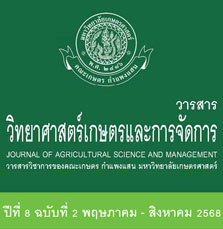Heat-Resistant Characteristic and Patulin Production Ability of Heat-Resistant Molds Isolated from Pineapple Field Soils
Keywords:
Heat-resistant mold, Ascospores, Patulin, Pineapple juice, Food safetyAbstract
Heat-resistant molds (HRMs) are a group of molds capable of producing ascospores that can withstand heat treatments at temperatures as high as 75°C for at least 30 min. The presence of HRM ascospores presents a significant challenge in the pasteurization of fruit juices. Moreover, some strains of HRMs can produce mycotoxins, which are harmful to consumers. This study aimed to characterize HRMs isolated from pineapple field soils in Chonburi and Kamphaeng Phet provinces, Thailand. The results revealed that HRMs were present in all soil samples. Subsequently, 60 representative isolates were randomly chosen to evaluate their ascospores-producing ability, which included 5 genera namely Aspergillus (with a neosartorya morph), Talaromyces, Penicillium (with an eupenicillium morph), Hamigera, and Paecilomyces (with a byssochlamys morph). Among these isolates, 28 isolates demonstrated the capacity to produce heat-resistant ascospores. Furthermore, this study observed patulin-producing capabilities in Paec. niveus and P. setosum strains, they produced patulin toxin in pineapple juice at higher concentrations, approximately 110 mg/mL. These findings emphasize the significance of the presence of these HRMs in pineapple field soils, as they can produce heat-resistant ascospores, and some strains are capable of producing patulin, which can lead to spoilage in pineapple and other fruit juices
References
กระทรวงสาธารณสุข. 2563. ประกาศกระทรวงสาธารณสุข (ฉบับที่ 414) พ.ศ. 2563 ออกตามความในพระราชบัญญัติอาหาร พ.ศ. 2522 เรื่อง มาตรฐานอาหารที่มีสารปนเปื้อน. ราชกิจจานุเบกษา เล่ม 137 ตอนพิเศษ 118 ง. 13หน้า.
ธิดา เดชฮวบ และ เลขา มาโนช. 2553. การศึกษาเชื้อราที่เจริญในอุณหภูมิสูงและราทนความร้อนจากดินและเศษซากพืชที่เหลือจากการเกษตร, หน้า 523-529. ใน : เรื่องเต็มการประชุมทางวิชาการของมหาวิทยาลัยเกษตรศาสตร์ ครั้งที่ 48: (สาขาพืช). มหาวิทยาลัยเกษตรศาสตร์, กรุงเทพฯ.
Ayesha, F. and P.Viswanath. 2006. Byssochlamys spp in sugarcane juice and its significance. Journal of Food Science and Technology (India) 43(4): 407-409.
Dijksterhuis, J., T. Wyatt, M. Hanssen, E. Golovina, F. Hoekstra and L. Lugones. 2021. Abundant small protein ICARUS inside the cell wall of stress-resistant ascospores of Talaromyces macrosporus suggests a novel mechanism of constitutive dormancy. Journal of Fungi (Basel) 7(3):216.
Eamvijarn, A. 2013. Neosartorya species: diversity, morphology, phylogeny, antagonistic tests against plant pathogenic fungi and secondary metabolites of N. pseudofischeri. Ph.D. Thesis, Kasetsart University.
Evelyn, E., C. Chairul, S. Aryuda, and I. Ainunnisa. 2022. Resistance of Eupenicillium javanicum mold spores to the light-emitting diode (LED), LED-assisted thermal and thermal processing in strawberry and apple juices. CRFS 5: 1524-1529.
Frisvad, J.C. 2018. A critical review of producers of small lactone mycotoxins: patulin, penicillic acid and moniliformin. World Mycotoxin Journal 11 (1): 73-100.
George, T.K., D. Devadasan and M.S. Jisha. 2019. Chemotaxonomic profiling of Penicillium setosum using high-resolution mass spectrometry (LC-Q-ToF-MS). Heliyon 5 (2019): e02484.
Glaser, N., and H. Stopper. 2012. Patulin: mechanism of genotoxicity. Food and Chemical Toxicology 50: 1796–1801.
Graça, J., K. Daly, G. Bondi, I. Ikoyi, F. Crispie, R. Cabrera-Rubio, P.D. Cotter, and A. Schmalenberger. 2021. Drainage class and soil phosphorus availability shape microbial communities in Irish grasslands. European Journal of Soil Biology 104: 103297.
Hammami, W., R.A Thani, S. Fiori, S. Al-Meer, F.A. Atia, D. Rabah, Q. Migheli and S. Jaoua. 2017. Patulin and patulin producing Penicillium spp. occurrence in apples and apple-based products including baby food. The Journal of Infection in Developing Countries 11(4): 343-349.
Kikoku, Y. 2006. Heat activation characteristics of Talaromyces ascospores. Journal of Food Science 68: 2331-2335.
Luangsa-ard, J.J., L. Manoch, N. Hywel-Jones, S. Artjariyasripong and R.A. Samson. 2004. Thermotolerant and thermoresistant Paecilomyces and its teleomorphic states isolated from Thai forest and mountain soils. Agriculture and Natural Resources 38(1): 94-101.
Muneer, M.A., X. Huang, W. Hou, Y. Zhang, Y. Cai, M.Z. Munir, L. Wu, and C. Zheng. 2021. Response of fungal diversity, community composition, and functions to nutrients management in red soil. Journal of Fungi 7(7): 554.
Puel, O., P. Galtier and I.P. Oswald. 2010. Biosynthesis and toxicological effects of patulin. Toxins (Basel) 2 (4): 613-31.
Rico-Munoz, E., 2017. Heat resistant molds in foods and beverages: Recent advances on assessment and prevention. Current Opinion in Food Science 17: 75-83.
Rico-Munoz, E., J. Houbraken, and R.A. Samson. 2015. Detection and enumeration of heat resistant moulds, pp. 251–263. In Y. Salfinger and M.L. Tortorello, (eds.). Compendium of Methods for the Microbiological Examination of Foods, Fifth ed. APHA Press. Washington D.C., USA.
Samson, R.A., J. Houbraken, J. Varga and J.C. Frisvad. 2009. Polyphasic taxonomy of the heat resistant ascomycete genus Byssochlamys and its Paecilomyces anamorphs. Persoonia 22: 14–27.
Sant'ana, A.S., A. Rosenthal and P.R. Massaguer. 2009. Heat resistance and the effects of continuous pasteurization on the inactivation of Byssochlamys fulva ascospores in clarified apple juice. Journal of Applied Microbiology 107 (1): 197–209.
Santos, J.L.P., S. Samapundo, A. Biyikli, J.V. Impe, S. Akkermans, M. Höfte, E.N. Abatih, A.S. Sant'Ana and F. Devlieghere. 2018. Occurrence, distribution and contamination levels of heat-resistant moulds throughout the processing of pasteurized high-acid fruit products. International Journal of Food Microbiology 281: 72-81.
Techakanon, C. and K. Venkatachalam. 2021.The effects of pasteurization conditions and storage time on microbial safety, quality and antioxidant properties of cider from rose apple (Syzygium agueum Alston cv. Taaptimjan). Chiang Mai University Journal of Natural Sciences 20 (2): e2021034.
Tranquillini, R., N. Scaramuzza and E. Berni. 2017. Occurrence and ecological distribution of heat resistant moulds spores (HRMS) in raw materials used by food industry and thermal characterization of two Talaromyces isolates. International Journal of Food Microbiology 242: 116-123.
Wyatt, T.T., M. Leeuwen, E.A. Golovina, F.A. Hoekstra, E.J. Kuenstner, E.A. Palumbo, N.L. Snyder, C. Visagie, A. Verkennis, J.E. Hallsworth, H.A.B. Wösten and J. Dijksterhuis. 2015. Functionality and prevalence of trehalose-based oligosaccharides as novel compatible solutes in ascospores of Neosartorya fischeri (Aspergillus fischeri) and other fungi. Environmental Microbiology 17(2): 395–411.






